March was warmer and wetter than average across the state, continuing the pattern from winter. The preliminary statewide average March temperature was 43.5 degrees, 2.20 degrees above the 30-year normal and the 28th warmest on record going back to 1895. Preliminary statewide average total March precipitation was 3.96 inches, 1 inch wetter than the 30-year normal and tied for the 34th wettest on record.
Data are provisional and may change slightly over time
Persistent Warmth in March
Much like the first two months of 2020, March temperatures were consistently above the long-term average.
The first two months of the climatological winter season were much warmer than average, with very few cold air incursions. The plot below shows the March daily average temperature as a departure from average in Rockford. Since the start of 2020, over 70 percent of days in Rockford have been warmer than the long-term average. This has caused 2-inch and 4-inch soil temperatures to generally remain above freezing over this time, according to observations from the Illinois Climate Network (https://www.isws.illinois.edu/warm/soil/).
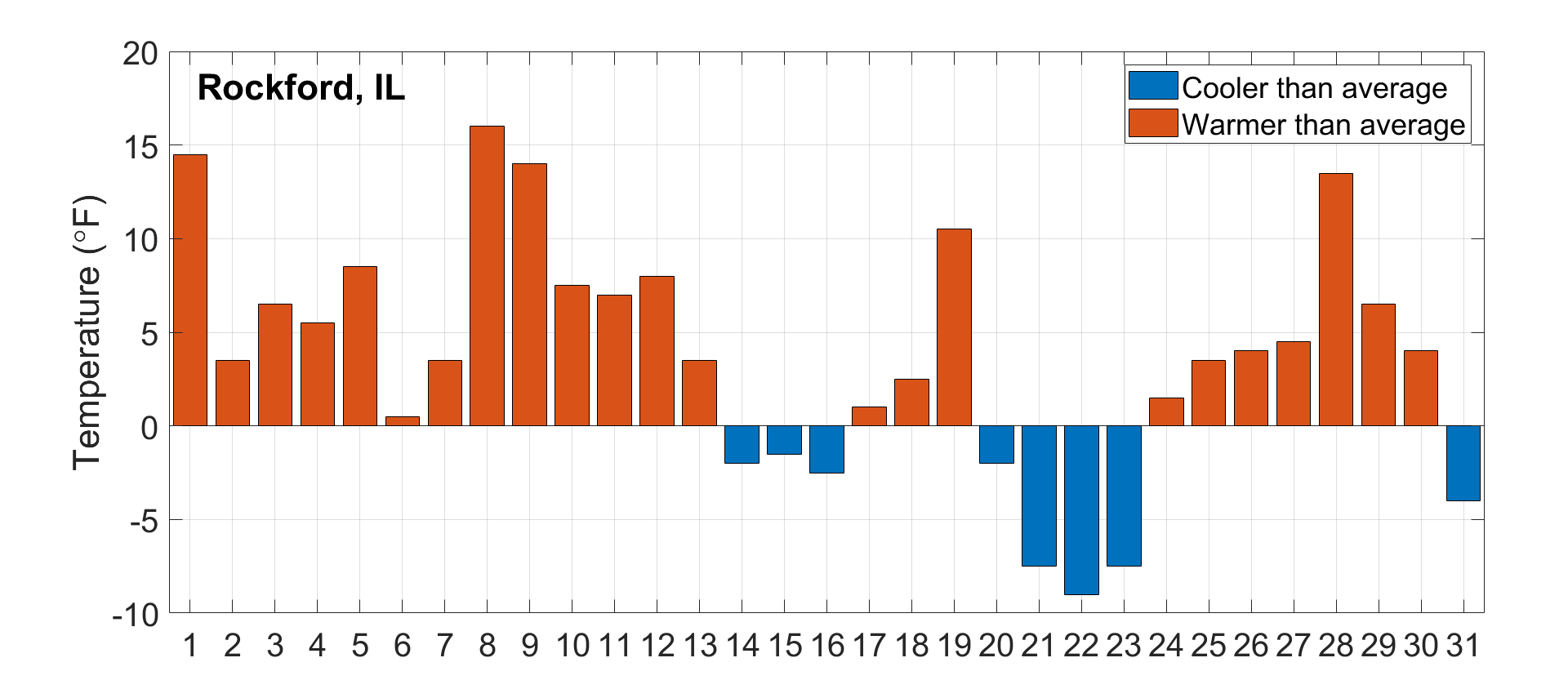
Average temperatures in March ranged from the high 30s in northern Illinois to the low 50s in southern Illinois. Temperatures ranged between 1 and 5 degrees above the long-term average. The statewide average March temperature was 43.5 degrees, which is 2.20 degrees above the 30-year normal and tied for the 28th warmest on record. March marked the fourth consecutive month with statewide average temperatures above the 30-year normal. By comparison, the first three months of 2019 were all 1 to 3 degrees below the 30-year normal, considerably cooler than 2020 so far.
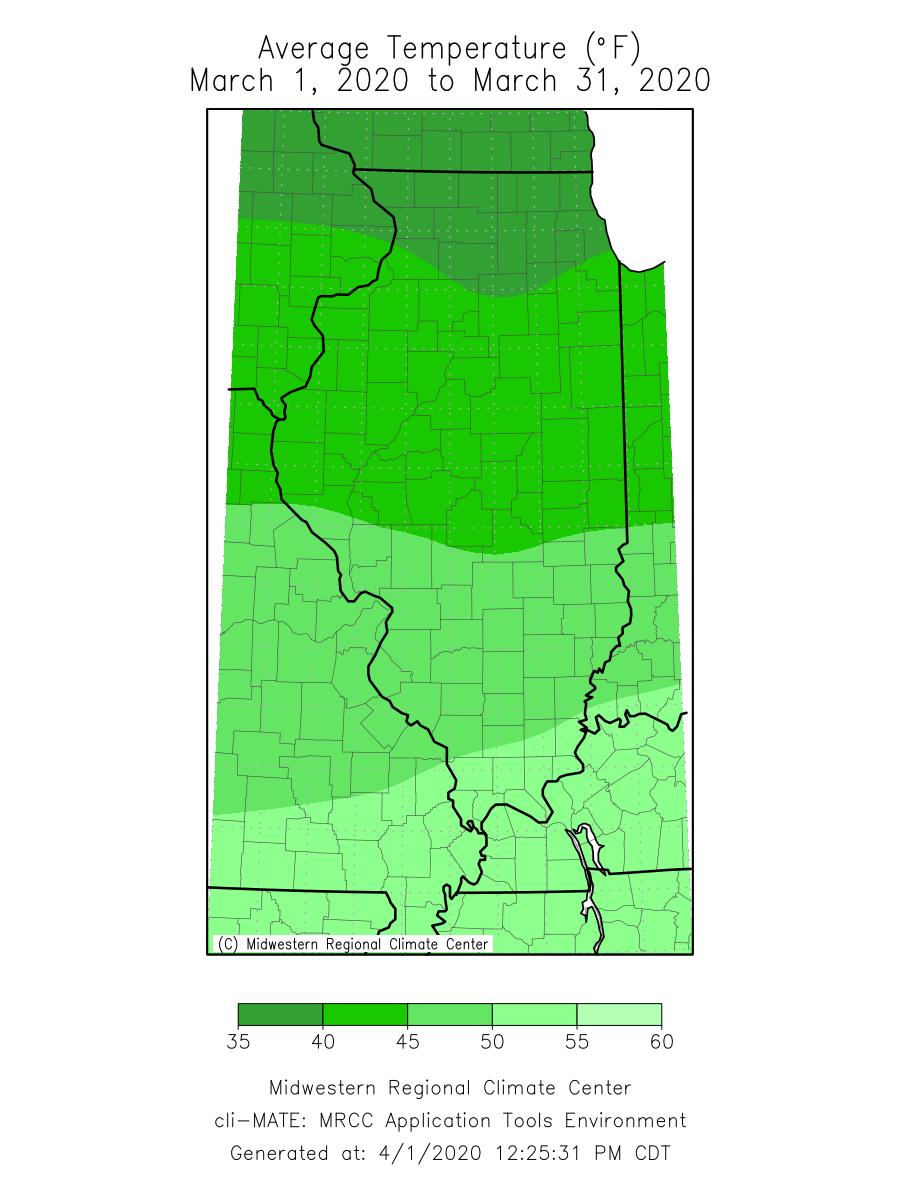
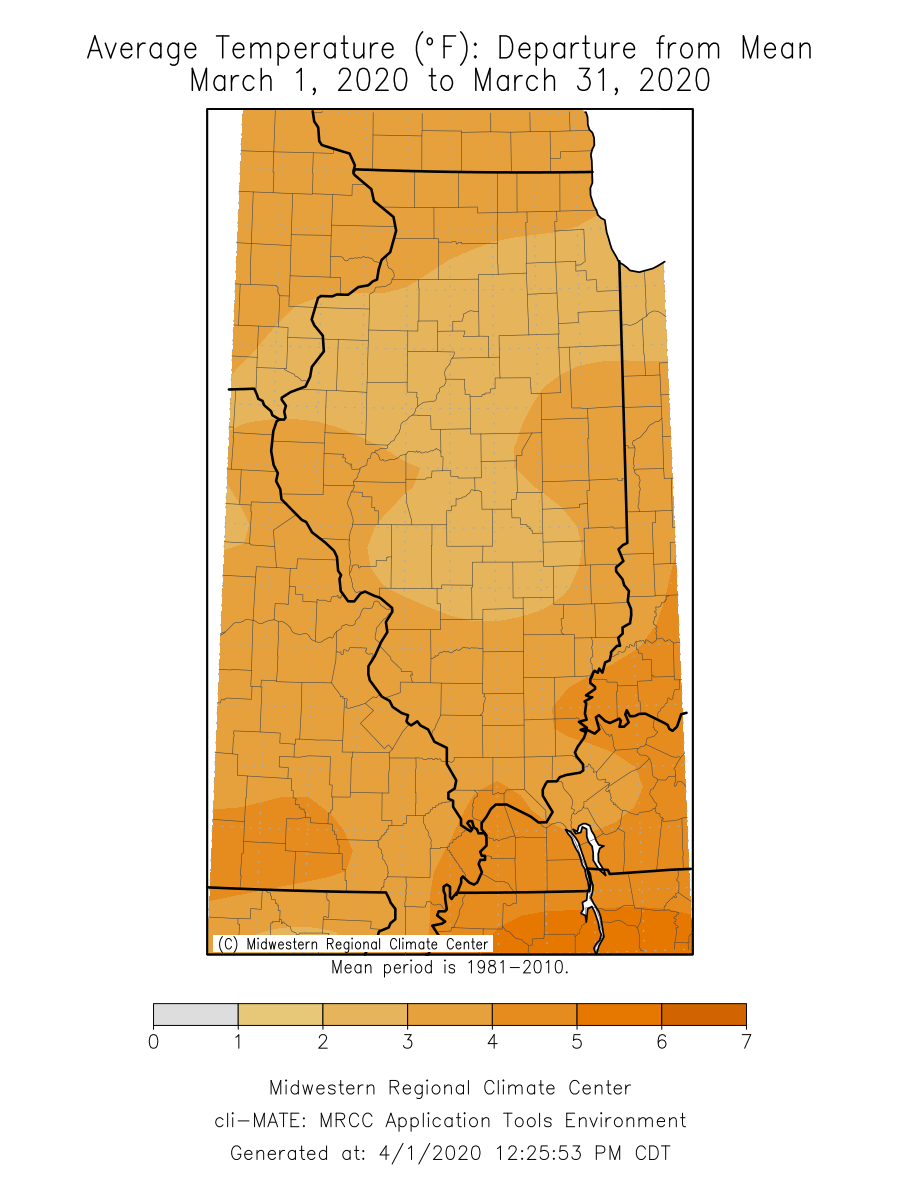
The warm weather in March resulted in three daily high maximum temperature records and seven daily high minimum temperature records being broken across the state. The few cold, cloudy days we had in March also resulted in six daily low maximum temperature records and one daily low minimum temperature record being broken across the state. The long-running station in Carbondale was only 1 degree away from its all-time March high minimum temperature record on March 28, thanks to a strong mid-latitude warm sector bringing warm air from the south. Multiple stations in southern Illinois recorded daily maximum temperatures at or over 80 degrees during the last week in March. At one of these stations, Fairfield in Wayne County, this was two weeks before the average first 80-degree day based on the long-term record.
The highest temperature recorded in the state in March was 81 degrees in Alexander, Pope, and Hardin Counties, while the lowest temperature was 8 degrees in Jo Daviess, Knox, and Whiteside Counties.
Storms Bring Heavy Rain to Northern and Southern Illinois
Frequent precipitation persisted from February into March for the southern part of the state. Most areas south of Interstate 64 received over 6 inches of total precipitation in March, and some areas received over 8 inches. This represents between 150 percent and 200 percent of normal March precipitation in southern Illinois (see map below). Most stations in southern Illinois received 50 percent or more of their total March precipitation in one 24-hour period between March 20 and 21, thanks to a series of storms that tracked across the region.
One-day precipitation totals reached 4.50 inches in Clay County, which set the all-time March one-day precipitation record at the station in Clay City and broke the previous record by over three-quarters of an inch. Other large one-day totals from the March 20 storms included 3.85 inches in Mt. Vernon in Jefferson County and 3.55 inches in Olney in Richland County. With these one-day totals subtracted, March 2020 was very close to March 2019 total precipitation in southern Illinois; however, because of this event, most areas in southeast Illinois received between 1.5 and 2.5 times the amount of March 2019 precipitation this month.
Although March precipitation totals in northern Illinois were not as generous as those in the south, northern Illinois was not averse to very large one-day precipitation totals. A series of storms that moved through on March 28 generated between 3 and 4 inches of precipitation in a less than 24-hour period for a stretch of Illinois between the Quad Cities and the western suburbs. One CoCoRaHS observer in Prophetstown in Whiteside County recorded 5.34 inches on this day. Unfortunately, the heaviest precipitation missed the longer-term COOP stations in the region, but the storm did manage to break the all-time March one-day precipitation total in DeKalb.
Total March precipitation ranged from over 8 inches in far southern and southeast Illinois to just over 2 inches in central Illinois. These totals ranged from over 200 percent of average March precipitation in southeastern and northern Illinois to just over 75 percent of average March precipitation in western Illinois. Most of central Illinois received between 75 percent and 125 percent of average March precipitation. This combined with above average temperatures allowed soils to dry a bit across central and western Illinois.
Last month was the wettest March on record at Rock Island Lock & Dam 15, with 6.17 inches recorded. The wettest place in the state last month was Clay City with 8.31 inches.
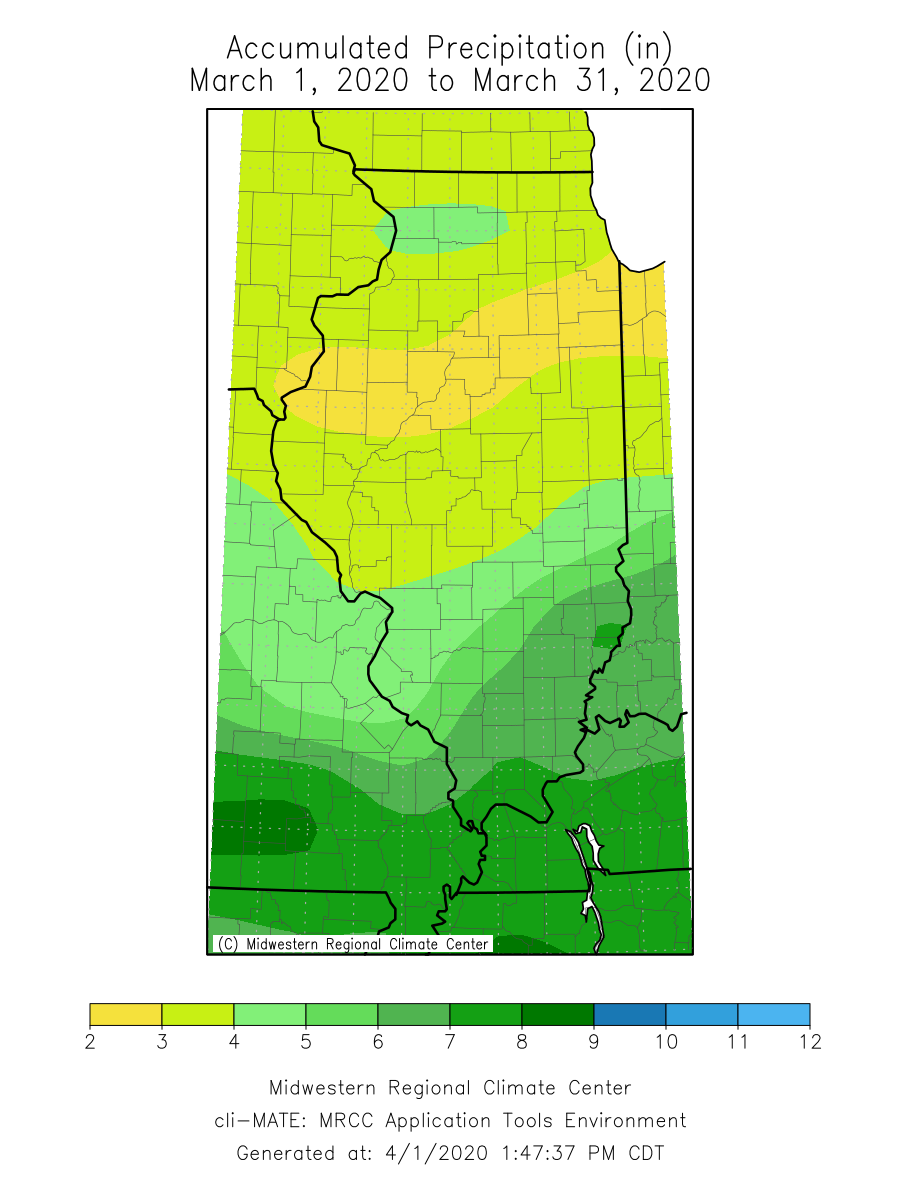

Overall, the preliminary statewide average total March precipitation was 3.96 inches, exactly 1 inch more than the 30-year normal and the 34th wettest on record. Although the March average does not reflect the 5- to 6-inch differences in precipitation between central and northern/southern Illinois.
Most of the northern half of the state experienced measurable snowfall last month. March totals ranged from around 6 inches in northeast Illinois to just over one-tenth of an inch along the Interstate 70 corridor. A winter storm on March 22 and 23 accounted for the vast majority of snowfall in the northern part of the state, with one-day totals exceeding 6 inches in Grundy County. Morris in Grundy County was the snowiest point in the state in March, with just over 7 inches of total snowfall.

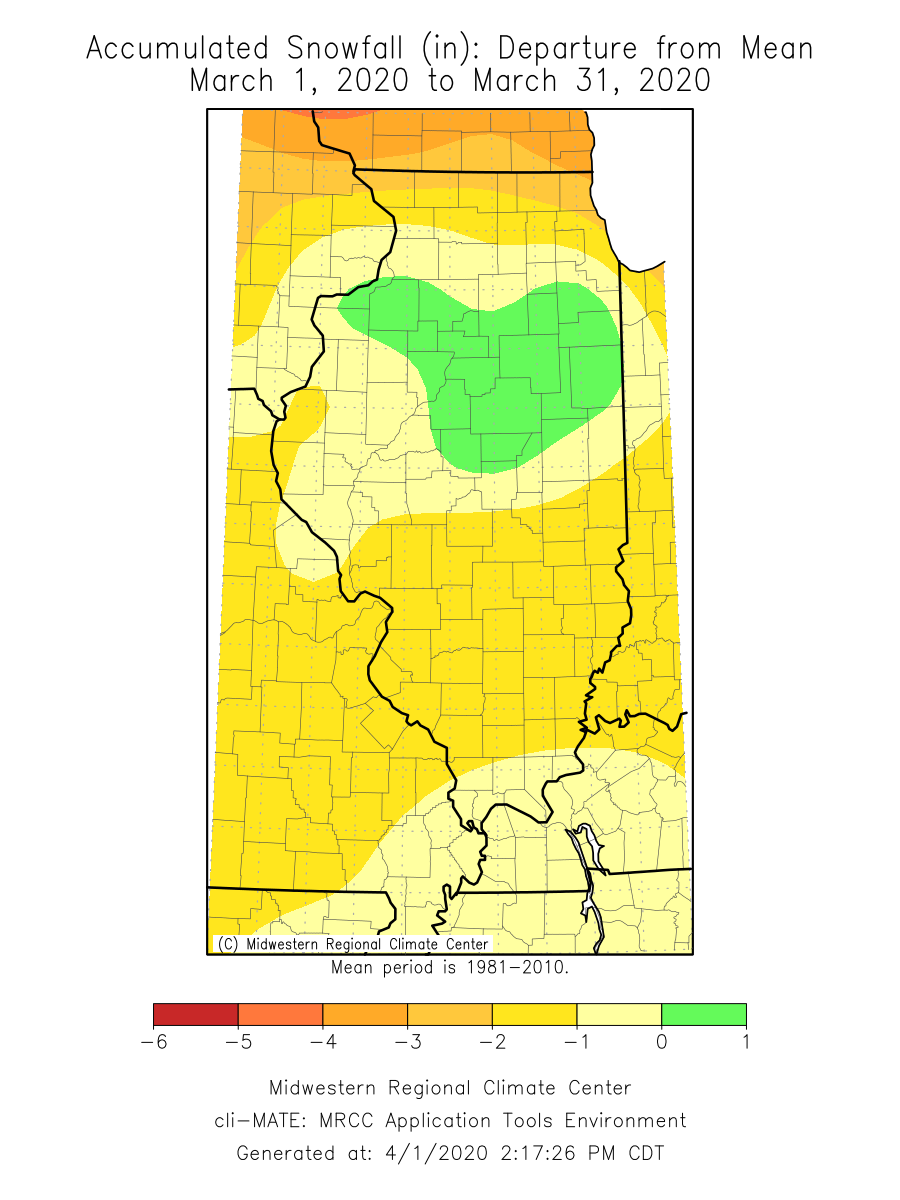
March total snowfall departures mimic the spatial patterns for the entire winter season. Most areas of western, northwest, and west-central Illinois had totals within 5 inches of the long-term average, whereas most counties south of Interstate 70 as well as counties in the Chicagoland metro area have experienced 5 to 10 inches below average snowfall since the first snow of the season.
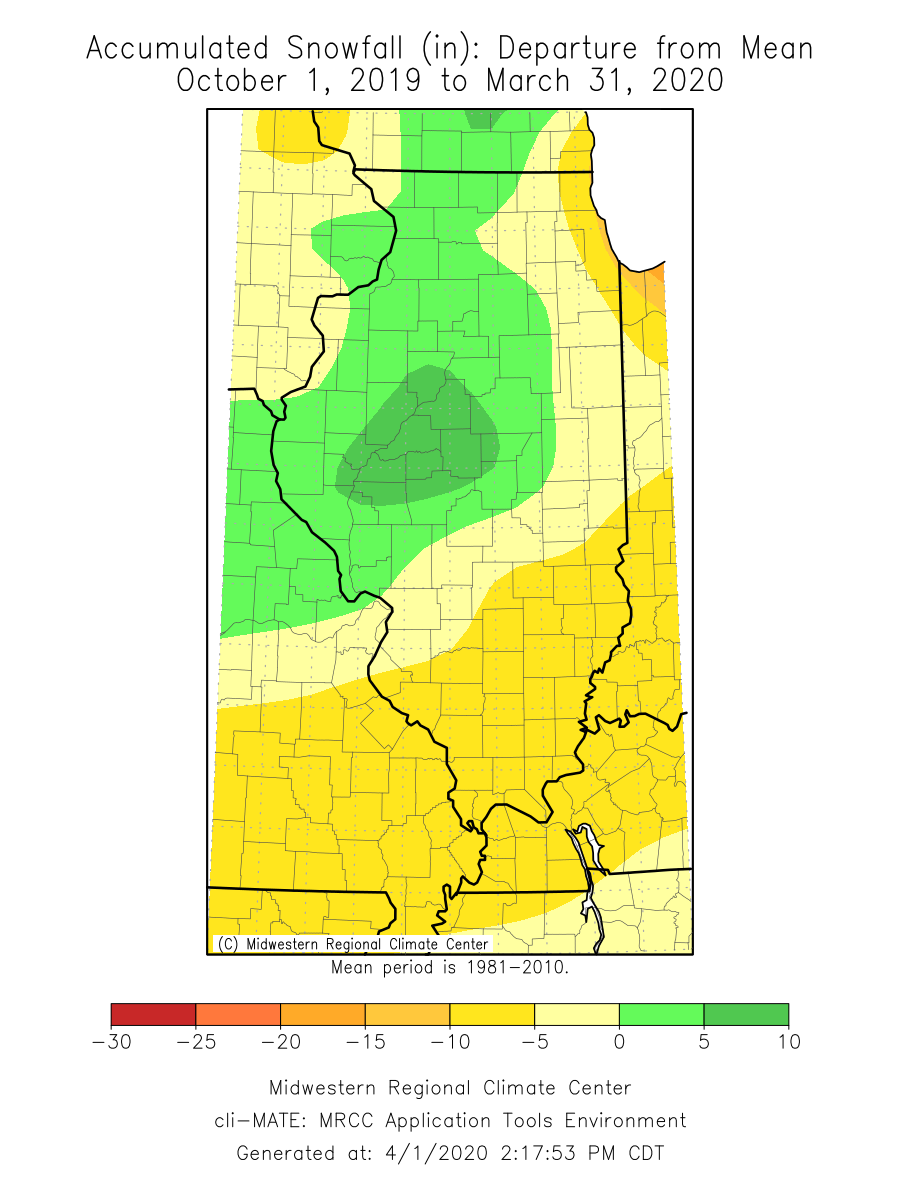
Severe Weather
Illinois experiences severe weather and storms in all calendar months, but March often begins the unofficial severe weather season. This last month we had numerous severe weather and storm reports, ranging from snowstorms to large hail and a few tornadoes. Trained spotters reported 2-inch hail in both Williamson and Vermilion Counties last month, with many more reports of 1.5- to 1.75-inch hail across southern and central Illinois. The AWOS station in Hyde Park in Cook County recorded a 61 mph non-thunderstorm wind gust on March 29. Finally, multiple tornadoes were reported in Illinois last month in southern and west-central Illinois, including three tornadoes between Peoria and the Quad Cities on March 28. One of these, an EF-1 tornado, developed just a quarter mile east of the Peoria International Airport, according to the Lincoln National Weather Service https://www.weather.gov/ilx/032820Tornadoes).
Outlooks
Short-term 8-14-day outlooks from the NOAA Climate Prediction Center show strongly elevated odds of both above normal precipitation and above normal temperatures across the state.

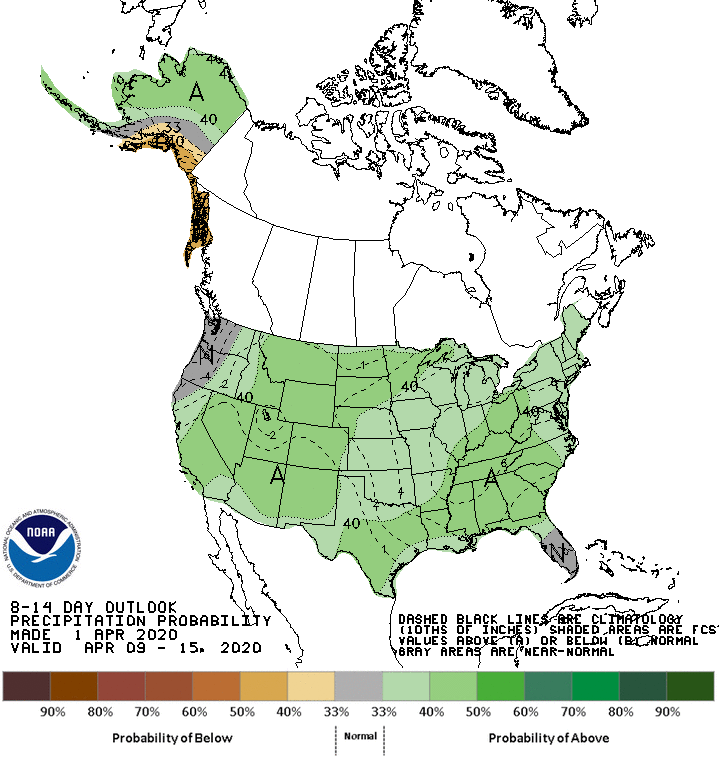
Longer-term 30-day outlooks are similar to the 8-14 day outlooks, with continued elevated chances of warmer and wetter conditions across the state for April.


Heavy precipitation in northwest and southern Illinois, combined with continual snowmelt in the Upper Midwest has continued the threat of flooding along most major rivers in Illinois. Currently, gauges along the Mississippi, Ohio, Illinois, and Wabash Rivers are at or above minor flood stage, with nine gauges in moderate flooding, according to the National Weather Service River Forecast Center.


